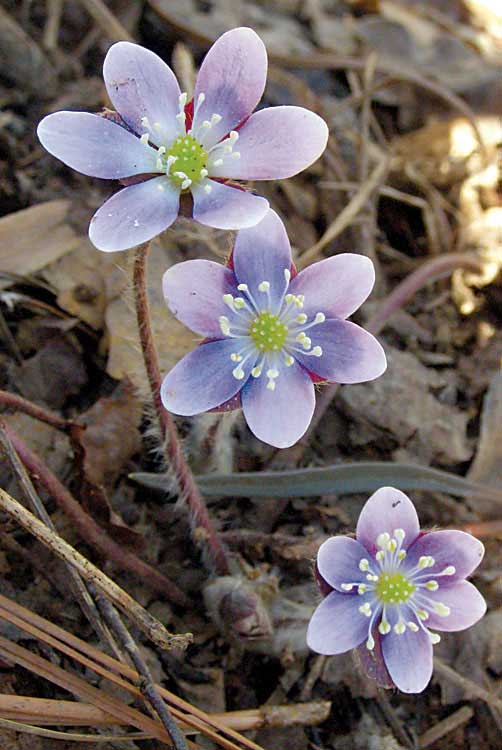Making the emergence of spring

Harbinger of spring: flowers of Hepatica. Photo by Ken Moore
By Ken Moore
Flora Columnist
You have to take care to avoid stepping on the Hepaticas when you approach the bench to sit and enjoy the sights and sounds along New Hope Creek at the old mill site. It’s springtime on Triangle Land Conservancy’s Johnston Mill Nature Preserve; Hepaticas and other spring wildflowers are emerging.
Johnston Mill Nature Preserve is just one of several that Triangle Land Conservancy (TLC) manages throughout Chatham, Durham, Johnston, Lee, Orange and Wake counties. It is well worth your investigating the website, www.tlc-nc.org, for site descriptions and a schedule of seasonal interpretive walking and canoe excursions in these preserves.
The 296-acre Johnston Mill Nature Preserve is my favorite because it has so many diverse habitats and there are some really interesting botanical features there. Those Hepaticas are one of them. Hepatica americana, commonly called Liverleaf, usually occurs on mature forest slopes above the flood plain. Here in the Johnston tract, they are scattered among the carpets of Trout Lily, Erythronium americanum, and Spring Beauty, Claytonia virginica, on the low-lying areas bordering the creek. The traditional first sign of spring is the emergence of the Hepatica flower just above the forest leaf litter. The blue color of that flower is indescribable. When you spot the flowers, look for the three-lobed evergreen leaves, which turn deep burgundy before they decompose to make way for the new leaves.
Another spring harbinger, Spicebush, Lindera benzoin, is easy to spot throughout the flood plain; look for tiny lemon-yellow flowers on the bare branches of head-high shrubs. Those inconspicuous flowers produce brilliant red berry-like fruit in late summer.
A second interesting feature for me is the warty bark of Celtis laevigata, commonly called Hackberry or Sugarberry. The smooth trunk of this tree is usually covered with wart-like corky growths, but a particular grove of trees near the old Johnston Mill site sports such dramatically warty bark that they are easily imagined to be characters from a Tolkienesque plot. You have to see them to believe them!
And another seeing-is-believing feature is the Lilliputian forest of American Beech, Fagus grandifolia, high up on the Bluff Trail. Normally, beech trees occur on the moist lower slopes, not high up on dry ridges. Here, however, a few large beech trees near the top of the slope were blown down during Hurricane Fran in 1996. Those trees were loaded with beech nuts. Each time I visit, I visually try to excavate the roots to determine whether that dwarf beech forest is the result of hundreds of sprouting beechnuts or vegetative sprouts from the extensive far-reaching root system of those original trees. It could be a combination of both.
More a wonder than a feature is the old, blown-over sycamore, Platanus occidentalis, on the creek bank. Though much of its massive root system is exposed, the tree, another Tolkienesque image, continues to survive and is a living demonstration of the complexity of a single-tree root system.
There is so much to see, and I advise you that if you don’t get outside now you’ll miss the awesome emergence of spring.
This coming Saturday, March 15, TLC is continuing its 25th year anniversary celebration with an all-day “Open House†at the Johnston Mill Nature Preserve. All are welcome, young and old, families and friends, to join in on this day-long walking celebration. What an appropriate way to pay tribute to TLC for protecting over 10,000 acres of natural areas in our region.
From 9 to 11 a.m., volunteer birders stationed throughout the preserve will help visitors spot and identify the many birds that migrate through or call Johnston Mill home. The roster of bird species here is so diverse that the preserve has been made a part of the North Carolina Birding Trail.
During the afternoon, from 1 to 4 p.m., volunteer naturalists and botanists will take over, helping visitors spot the Hepaticas and other features of spring. Spring is proceeding so rapidly now that there are budding surprises with each passing day.
All day long, volunteers will be on hand to greet visitors and share information about TLC. Parking for the open house is available at both entrances to the preserve: on Mt. Sinai Road and on Turkey Farm Road. For personal safety, TLC advises visitors to park on the shoulder of Turkey Farm Road if the lots are full. Visit the website for a Johnston Mill locator map.
Email Ken Moore at flora@carrborocitizen.com. Find previous Ken Moore Citizen columns at The Annotated Flora (carrborocitizen.com/flora).


Comments are closed.